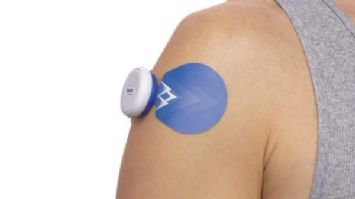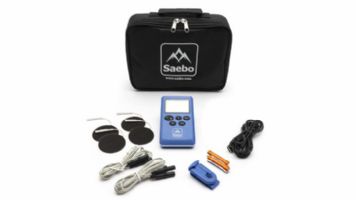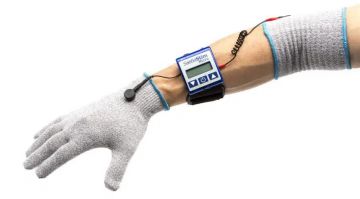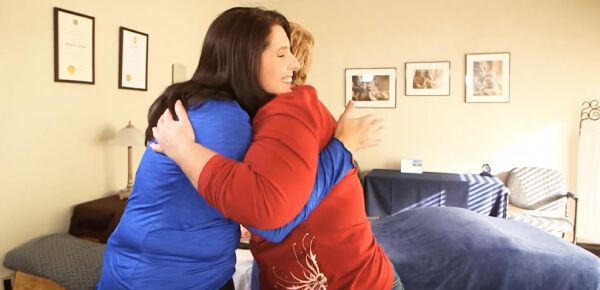 Written by Henry Hoffman, MS, OTR/L
Written by Henry Hoffman, MS, OTR/L
Electrical stimulation is one of several stroke recovery products that therapists use to treat patients. This type of treatment can be used to improve blood flow, relieve pain, ease muscle tension, and increase strength. Due to the variety of benefits this modality has, occupational (and physical) therapists have been using electrical stimulation to treat orthopedic concerns and help those who have experienced neurological incidents such as a stroke.
This event is quite common, since over 795,000 people have a stroke each year. As a result, electrical stimulation devices for stroke patients have been more widely used outside of therapy clinics. This stroke recovery product is compact, user-friendly, and affordable, which is why electrical stimulation devices for stroke patients are being used in the home to help individuals take a more active role in managing their symptoms.

Electrical stimulation uses small electrical impulses to cause muscle contraction. This is done by placing small, sticky pads (called electrodes) on parts of the skin - on top of the muscles that will be targeted. After making some adjustments to the settings on the device’s screen, a mild electrical current travels from the unit to the electrodes. These electrodes transfer those impulses to the underlying muscles, which then contract.
Anything involving electricity may seem daunting, but this evidence-based treatment is considered very safe. The impulses are provided at such low doses that they serve a therapeutic purpose. Depending on the intensity of the current, the placement of the electrodes, and a person’s movements during electrical stimulation, muscle contractions can encourage someone to regain motion after a stroke or other brain injury.
When this modality is used to retrain stroke patients on basic movements, it is more commonly referred to as neuromuscular electrical stimulation (aka NMES). Studies show that over 65% of individuals who experienced a stroke struggle with using their affected hand several months later. Electrical stimulation devices can serve this population with great benefits in terms of recovery potential.
.jpg)
As we mentioned, the initial result of electrical stimulation is a muscle contraction. However, muscles can only contract with the help of the brain, which is really the focus of the electrical stimulation device. The electrical current helps wake up certain parts of the brain that were impacted by the stroke. This activation encourages the brain to start its own healing by rewiring itself in a process called neuroplasticity. Such intricate rewiring does not happen overnight, which is why neuroplasticity prepares healthy parts of the brain to take over some functions until the injured brain areas are ready.
As a result, neuroplasticity can help:
.jpg)
This is the most common type of electrical stimulation used to benefit stroke patients. This follows the same process as we described above, but it is often used to increase muscle strength, lower spasticity (or tone), and increase active motion in the muscles being targeted.
When individuals use FES, they are aiming to improve their performance in practical, functional activities that have a distinct purpose in their daily life. This can mean self-care tasks that allow them to independently get themselves ready for the day or leisure activities and hobbies. Individuals who use FES will use the unit to improve active motion while they are practicing tasks such as gripping a doorknob, holding a pencil, or buttoning their shirts.
We mentioned that electrical stimulation can help individuals relieve pain. TENS is a form of electrical stimulation that may be used for stroke patients who experience discomfort. But it can also help those with orthopedic concerns such as muscle sprains, fractures, and post-surgical pain. TENS uses a very low electrical current – so low that individuals using it will not experience any muscle contractions. However, they will experience a slight tingling sensation, which is used to calm pain receptors that communicate with the brain.
Similar to TENS, SES is a low-current type of electrical stimulation that does not cause muscle contraction. The mild electrical currents are intended to trigger the sensory system to relieve spasticity, improve sensory function, and remediate neglect. Neglect is a stroke-related symptom that causes someone to lack awareness of one side of their body. As you can see, the sensory input would be given to that side of the body to assist with neglect.
While most of the other forms of electrical stimulation involve a muscle contraction that occurs solely due to the electrical current, ETS requires more participation from the patient. When receiving ETS, a patient must attempt the muscle movement (which ideally will elicit some or partial motion) and the electrical stimulation will complete the remainder of the movement with the current.
RETS is especially suited for individuals who have experienced overactive muscles as a result of a stroke. For example, if a patient’s hand is shut into a tight fist, which is usually the result of spasticity in those muscles, RETS can assist in helping them gradually open their hand. In this case, RETS is used to relax a patient’s tight hand muscles before providing electrical current to the muscles that allow the hand to open.
 | SaeboStim One Wireless EMS Unit View Product |
This electrical stimulation device for stroke patients is not only wireless, but it’s also wearable, making it a great option for busy and active individuals. This device utilizes NMES to help those with shoulder subluxation or foot drop. Shoulder subluxation and foot drop both stem from weak or inactive muscles that are unable to hold the shoulder and ankle joints into place. As a result, the bones in the shoulder and ankle joints separate. By wearing the SaeboStim One Wireless EMS Unit, individuals can conveniently prevent these stroke-related complications.
 | SaeboStim Pro | NMES, TENS, and E Stim Machine View Product |
If you are looking for a wider range of offerings from your electrical stimulation device, the SaeboStim Pro is the way to go. With the option of TENS, NMES, SES, FES, and basic electrical stimulation, the SaeboStim Pro | NMES, TENS, and E Stim Machine offers customizable programs so individuals can integrate electrical stimulation into their lives easily. With a simple trigger button, an individual can independently begin using the SaeboStim Pro while completing functional tasks, which is an excellent way to see great results. This device can be used on the upper or lower body, so it is versatile enough to assist with a range of stroke-related symptoms.
 | SaeboStim Micro | E Stim Machine View Product |
We mentioned the role that electrodes play in the use of an electrical stimulation device, but the SaeboStim Micro | E Stim Machine offers a more unique and practical application. This device comes with a sleeve and a glove so it is securely fitted to the forearm and hand. The SaeboStim Micro is intended to provide only SES, but its highly convenient design allows it to be worn during the day or night. This type of electrical stimulation does not target the muscles so you should not expect muscle contractions, which may get in the way of daily activities. Instead, you can gently stimulate the sensory system to get more subtle benefits.
If you were previously concerned about the safety of electrical stimulation, you can rest assured since it can be combined with a foot bath without concern. The SaeboStim Spa Neuropathy Foot Bath for Stroke Recovery offers individuals a relaxing foot soak while they reap the benefits of lower pain levels, less spasticity, and greater sensation. Anyone who loves to soak their feet in epsom salts after a long day will be doing themselves a favor by utilizing this neuropathy foot bath.
Individuals who have pacemakers, are pregnant, suffer from epilepsy, or have an irregular heartbeat(called atrial fibrillation) should not use any form of electrical stimulation. Since this modality uses electrical currents, that energy can cause complications in any of the above individuals.

Electrical stimulation is most suitable for individuals who are active and motivated to regain movement after sustaining a stroke. This treatment produces the best results if someone regularly adheres to a program and uses their device daily (or as frequently as is recommended by their therapist). Electrical stimulation is also ideal for individuals who are adding it with physical or occupational therapy, since this produces the best functional outcomes.

For most units, no. Usually, individuals can get and use an electrical stimulation device without any prescription. However, there are some combo units that do require a prescription. And if you have any questions or concerns about using a unit, it’s best to consult with your doctor or another healthcare professional.

There are a range of benefits associated with electrical stimulation devices for stroke patients. Individuals can get pain relief from TENS, improvements in functional use with FES, greater active motion with NMES, better sensation with SES, and more. Many devices can help individuals who have experienced strokes by reducing complications such as edema, shoulder subluxation, and foot drop. Our favorite stroke recovery products are by the brand Saebo! Feel free to browse all Physical Therapy Devices for Stroke Recovery.
Interested in learning more? Check out all stroke recovery articles, where we provide product reviews, buying guides, stroke exercises, and more information on stroke recovery! And check out our main blog, Caregiver University, for content on aging in place, wheelchairs, caregiving, special needs, and many more important topics.
Thanks for reading!

Henry is known as a purveyor of neuroplasticity-based treatment and co-founder of Saebo, a leading provider of novel and evidence-based stroke recovery solutions. For over 20 years, he has provided hundreds of national and international brain injury/stroke courses certifying thousands of occupational and physical therapists worldwide.
Henry’s first stroke product, the SaeboFlex, was placed on permanent public display at the Wellcome Medicine Galleries exhibit at the Science Museum in London. The SaeboFlex was alongside other medical breakthrough technologies spanning the last 500 years, including the first MRI machine and the penicillin mold.
Saebo’s tagline is “No Plateau in Sight” with the understanding that there is no expiration date on neuroplasticity. Henry believes that patients can continue to make gains many years post-stroke and live a happy, healthy, and more independent life.